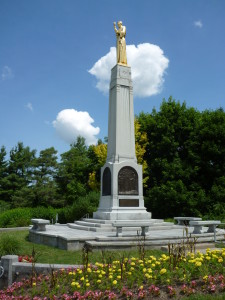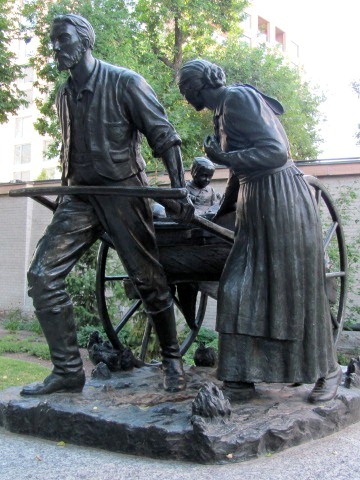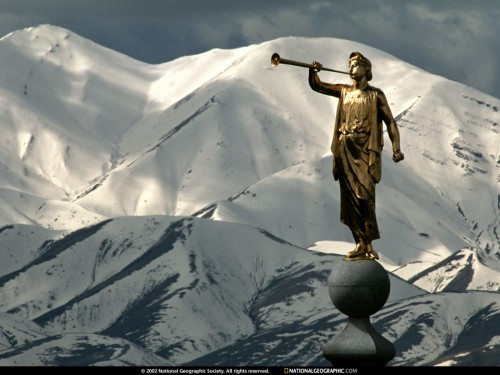 Torleif S. Knaphus was born in Norway on December 14, 1881. At a very young age his parents noticed his extreme talent for art. They encouraged it, and he developed his skills. At age 15, Torleif became an art apprentice painting houses and decorative furniture. In 1901, he traveled to Oslo to pursue more formal art studies. While there, his roommate invited him to attend a Latter-day Saint concert. He enjoyed the concert and began attending meetings of The Church of Jesus Christ of Latter-day Saints (which church is often misnamed the “Mormon Church”). He said, “It was easy for me to see and understand that this was the only true Church of God.”
Torleif S. Knaphus was born in Norway on December 14, 1881. At a very young age his parents noticed his extreme talent for art. They encouraged it, and he developed his skills. At age 15, Torleif became an art apprentice painting houses and decorative furniture. In 1901, he traveled to Oslo to pursue more formal art studies. While there, his roommate invited him to attend a Latter-day Saint concert. He enjoyed the concert and began attending meetings of The Church of Jesus Christ of Latter-day Saints (which church is often misnamed the “Mormon Church”). He said, “It was easy for me to see and understand that this was the only true Church of God.”
Torleif was baptized at the age of 21 in a river that was frozen and had to be cut with a saw. His love of the gospel and strong testimony caused him to turn down an art scholarship to Rome in order to immigrate to Utah in 1905. That was the beginning of Torleif’s lifelong association with church art projects. He worked on many, many temples and was even called to serve a mission in Paris just to study art. This time was a wonderful boon to him, especially since he had given up the chance to study in Rome.
 Upon returning home, Torleif continued his work on temples and in the 1920s completed the original Handcart Pioneers statue. In 1947, he completed the larger replica of the same statue that is now displayed on Temple Square.
Upon returning home, Torleif continued his work on temples and in the 1920s completed the original Handcart Pioneers statue. In 1947, he completed the larger replica of the same statue that is now displayed on Temple Square.
Torleif’s artistic works for The Church of Jesus Christ of Latter-day Saints are found in many places around the United States. Perhaps none are so large and recognizable, however, as his monument of the angel Moroni which stands on the Hill Cumorah.
The Church acquired the land for the Hill Cumorah in 1928, and immediately Torleif recommended to the Brethren [church leaders] that a monument should stand there commemorating the important event of Moroni visiting Joseph Smith and giving him the brass plates.
While the Brethren had not commissioned Torleif to create this monument, Torleif felt so strongly about it that he created seven sketches on his own and went to the Lord in prayer for guidance about which sketch was the most accurate and if he should formally present his plan to the Brethren. One night in 1929 he climbed Ensign Peak in Salt Lake City and knelt in prayer, with his sketches spread out on the ground. In answer to his plea, an angel appeared to him and pointed to one of the sketches saying, “This is the one.” The angel also told Torleif to visit the Brethren in the church offices the next morning and that they would be waiting for him.
The next day, Torleif did as he had been instructed. The Brethren welcomed him and unanimously chose the picture the angel had singled out. Official permission to begin the project soon followed. Torleif was understandably very private about his encounter with the angel. He only shared his experience a couple of times, and when a friend asked him if the angel had been Moroni, Torleif said, “That’s my secret.” His second wife, Rebecca, though, said Torleif had told her it had been the angel Moroni.
The final statue of Moroni stands 9 feet tall and is gold plated. It rests on a granite pillar, which Torleif also created. He spent five years on the design and creation of the monument, which was more than double the time he spent on any other single work of art in his life.
 Immediately after Torleif had been granted permission to work on the project, he looked for a model. He found the physique he wanted in Elwin Clark, a bricklayer, but he felt Elwin’s face was too young to accurately represent the mature Moroni. He fasted and prayed for a suitable model for the face. One day an older gentleman caught his eye in the city. After following him for some time, Torleif approached the man and asked if he would consider being a model for him. He persuaded the man, who had just moved to Utah from Wyoming, to come with him to his studio right then.
Immediately after Torleif had been granted permission to work on the project, he looked for a model. He found the physique he wanted in Elwin Clark, a bricklayer, but he felt Elwin’s face was too young to accurately represent the mature Moroni. He fasted and prayed for a suitable model for the face. One day an older gentleman caught his eye in the city. After following him for some time, Torleif approached the man and asked if he would consider being a model for him. He persuaded the man, who had just moved to Utah from Wyoming, to come with him to his studio right then.
Elwin was already at the studio waiting for Torleif. To everyone’s surprise, Elwin recognized the older man as his father, Hyrum Don Carlos Clark. This “coincidence” confirmed to Torleif that these men were the appropriate models for him to use.
The monument was placed on the Hill Cumorah in 1935, which had been replenished during the previous year with 10,000 trees on its barren landscape. Each of the four sides of the base has a bronze plaque depicting a significant event which took place in the area: the west side shows Moroni delivering the plates to Joseph Smith; the south side shows Moroni revealing the plates to the three witnesses; the east side depicts Joseph Smith showing the plates to the eight witnesses; and on the north side is the text from Moroni 10:4–5, which reads, “And when ye shall receive these things, I would exhort you that ye would ask God, the Eternal Father, in the name of Christ, if these things are not true; and if ye shall ask with a sincere heart, with real intent, having faith in Christ, he will manifest the truth of it unto you, by the power of the Holy Ghost. And by the power of the Holy Ghost ye may know the truth of all things.”
The statue of Moroni shows him holding the plates in his left arm while raising his right arm to call attention to the gospel message. Other religious symbols are explained to visitors on nearby plaques.
As for Torleif’s personal life, he married Emilia “Millie” Helena Christensen in 1909 in the Salt Lake Temple. However, she passed away in 1931, leaving six children, the youngest just 15 months old. He refused to split up the family, despite offers from friends to adopt the younger children, and did his best to be both father and mother to his children until he remarried eight years later, a woman named Rebecca Marie Knaphus.
A reporter asked Torleif in the late years of his life what he considered his greatest work. He said, gesturing to some family photos and a pedigree chart on his wall, “My family and this genealogical research have been my greatest work in life.” Historians have estimated that Torleif personally submitted 10,000 of his Norwegian ancestors’ names for temple work. Elder LeGrand Richards of the Quorum of the Twelve Apostles said he knew of no other person who had done more genealogy work than Torleif. Torleif passed away June 14, 1965, at the age of 83.
It is easy to look back on Torleif’s life and see many turning points which led him to the gospel, but which could have gone another way. For example, what if his roommate had not invited him to attend that concert in the first place? God’s hand is truly guiding each of our lives. If we let Him, He will use us for His purposes and will make a masterpiece out of us. Torleif had such an impact for good in the lives of those around Him because He turned His life to God.
This article was written by Doris White, a member of The Church of Jesus Christ of Latter-day Saints.


 Watch a video about the restoration of the gospel on lds.org
Watch a video about the restoration of the gospel on lds.org
I surely appreciate your post, dwhite. As a fairly new member, I relish the history. Thank-you.